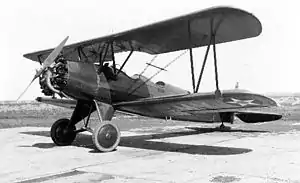Consolidated PT-3
The Consolidated Model 2 was a training airplane used by the United States Army Air Corps, under the designation PT-3 and the United States Navy under the designation NY-1.
| PT-3 | |
|---|---|
 | |
| Consolidated PT-3 | |
| Role | Trainer |
| Manufacturer | Consolidated Aircraft Company |
| Introduction | 1927 |
| Primary user | United States Army Air Corps |
| Produced | September 1927 |
| Number built | 250 |
| Variants | Consolidated NY, Consolidated O-17 |

Development
Seeing the success of the Navy's NY-1 modification of a PT-1 airframe, the USAAC came to the conclusion that a radial engine was indeed ideal for a trainer. It was reliable and offered a good power-to-weight ratio. Therefore, one PT-1 airframe was completed as XPT-2 with a 220 hp (164 kW) Wright J-5 Whirlwind radial engine.[1]
The XPT-3 was almost identical to the XPT-2 except for the tail, revised wing panels and different shape. 130 production PT-3 aircraft were ordered in September 1927,[1] with one being completed as the XO-17. These were followed by 120 PT-3A aircraft with minor changes. The XPT-3 became the XPT-5 when fitted with the Curtiss Challenger R-600 two-row six-cylinder radial engine, but was soon converted to PT-3 standard.[2]
The PT-3 aircraft were superseded by the Boeing PT-13 Stearman starting in 1937, but a number were still operational with the Spartan Flying School in Tulsa Oklahoma into the middle of World War II.[1]
Variants
- XPT-2
- one PT-1 airframe with a 220 hp (160 kW) Wright J-5 (R-790) radial engine, wingspan 34 ft 7 in (10.5 m), length 28 ft 4 in (8.6 m), gross weight 2,427 lb (1100 kg)[3]
- XPT-3
- one PT-1 airframe with revised wing panels (Clark "Y" wings) and a different vertical tail, wingspan 34 ft 6 in (10.5 m), length 28 ft 3 in (8.6 m), gross weight 2,439 lb (1106 kg)[3]
- PT-3
- 130 ordered, one completed as the XO-17 prototype, gross weight 2,481 lb (1125 kg)[3]
- PT-3A
- 120 ordered with minor updates, Wright J-5, gross weight 2,432 lb (1103 kg)[3]
- XPT-4
- unbuilt, was to be a development PT-3 with the experimental Fairchild-Caminez 447C engine[3]
- XPT-5
- the airframe of the XPT-3 was temporarily fitted with the Curtiss Challenger R-600-1 two-row six-cylinder radial engine in 1929, later converted to PT-3 standard[3]
Operators
- Cuban Air Force, ten PT-3s.[4]
- Argentine Air Force, one PT-3.
- Brazilian Naval Aviation, one PT-3, serial number 434.
- Peruvian Air Force, one PT-3.
- a small number may have been sold to Mexico
Specifications (PT-3)
Data from "United States Military Aircraft Since 1908" by Gordon Swanborough & Peter M. Bowers (Putnam Newy York, ISBN 0-370-00094-3) 1977, 675 pp.
General characteristics
- Crew: two
- Length: 28 ft 1 in (8.56 m)
- Wingspan: 34 ft 6 in (10.52 m)
- Height: 10 ft 3 in (3.12 m)
- Wing area: 300 ft2 (27.87 m2)
- Empty weight: 1,785 lb (810 kg)
- Max. takeoff weight: 2,481 lb (1,125 kg)
- Powerplant: 1 × Wright R-790-AB radial, 220 hp (164 kW)
Performance
- Maximum speed: 102 mph (164 km/h)
- Cruise speed: 81 mph (130 km/h)
- Range: 300 miles (483 km)
- Service ceiling: 14,000 ft (4,267 m)
- Rate of climb: 658 ft/min (200 m/min)
See also
- Consolidated PT-1 "Trusty"
- Consolidated O-17
- Consolidated PT-11
References
- "The Complete Encyclopedia of World Aircraft" cover Editors: Paul Eden & Soph Moeng, (Amber Books Ltd. Bradley's Close, 74-77 White Lion Street, London, NI 9PF, 2002, ISBN 0-7607-3432-1), 1152 pp.
- "United States Military Aircraft Since 1909" by F. G. Swanborough & Peter M. Bowers (Putnam New York, ISBN 0-85177-816-X) 1964, 596 pp.
- "U.S. Army Aircraft 1908-1946" by James C. Fahey, 1946, 64pp.
- Hagedorn 1993, p. 10
- Hagedorn, Daniel P. (1993). Central American and Caribbean Air Forces. Tonbridge, Kent, UK: Air-Britain (Historians) Ltd. ISBN 0-85130-210-6.
External links
![]() Media related to Consolidated PT-3 at Wikimedia Commons
Media related to Consolidated PT-3 at Wikimedia Commons